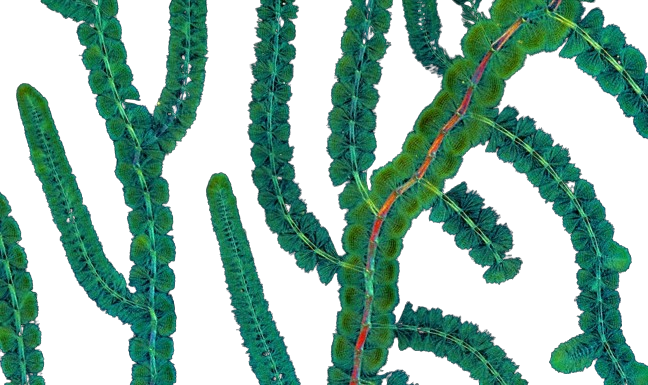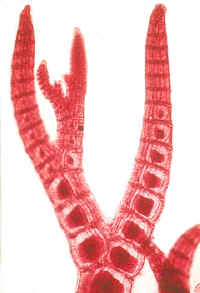Red algae, scientifically known as Rhodophyta, represent one of the oldest groups of eukaryotic algae, with over 5,000 recognized species. They are predominantly marine organisms, although some species inhabit freshwater environments (Batrachospermum) . Characterized by their reddish color, red algae derive this hue from the presence of pigments such as phycoerythrin and phycocyanin, which mask the green chlorophyll. This unique pigmentation allows them to photosynthesize efficiently at greater depths in the ocean, where blue light penetrates more effectively than other wavelengths. Besides these pigments, red algae possess some other accessory pigments such as Chlorophyll a, Chlorophyll b, Xanthophyll and Carotene.


Habitat
Red algae are predominantly found in marine environments, often attached to rocks or other substrates in shallow waters. They can thrive at considerable depths due to their ability to utilize blue light for photosynthesis, which penetrates deeper than other light wavelengths
General Characteristics
Red algae are distinguished by several key features as mentioned below-
Cell structure
They possess eukaryotic cells that lack flagella and centrioles, which are common in other algal groups. Their cell walls are composed of two layers, with the outer layer containing agarose and agaropectin, and the inner layer primarily made of cellulose.
Reproduction
Red algae exhibit complex reproductive cycles, including both sexual and asexual reproduction. The reproductive structures are non-motile, with male gametes produced in spermatangia and female gametes in carpogonia.
Ecological role
Red algae play a crucial role in marine ecosystems, serving as a food source for various organisms, including fish and invertebrates. They are also vital in the formation of coral reefs
Economic Importance
Food sources
Many species, such as Porphyra (nori), Chondrus crispus (Irish moss), and Palmaria palmata (dulse), are consumed in various cultures, particularly in East Asia. They are rich in vitamins, minerals, and dietary fiber, making them a valuable addition to human diets
Industrial applications
Red algae are harvested for their polysaccharides, such as agar and carrageenan, which are widely used as thickening agents in food products, cosmetics, and pharmaceuticals. Agar, in particular, is essential in microbiological media for culturing bacteria and fungi,
Nutritional benefits
Red algae are known for their high content of essential nutrients, including iodine, calcium, and antioxidants. They are also recognized for their potential health benefits, such as improving circulation, regulating blood sugar levels, and supporting immune function.